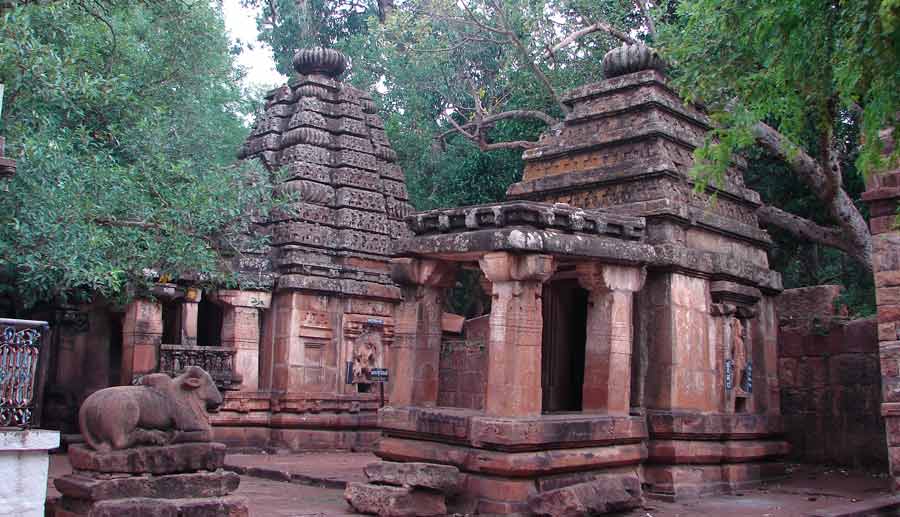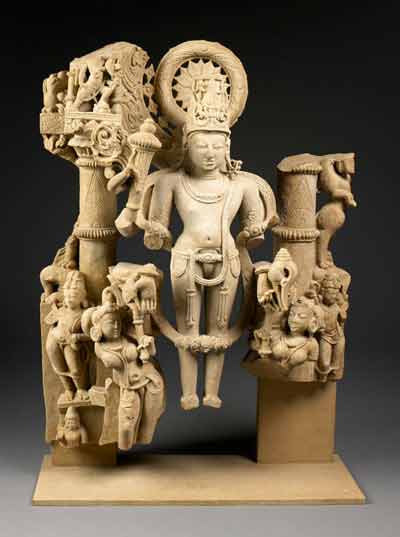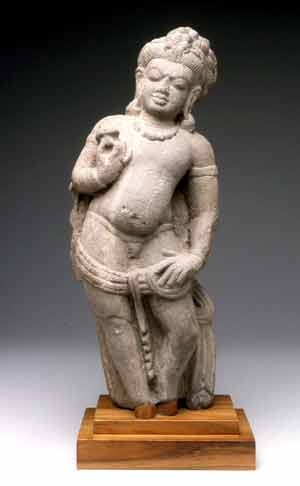
A Vishnu temple in nagara style on the left. The Mahakuta group of temples were consecrated by the Badami Chalukyas in the 6th-7th century time period in Mahakuta, Bagalkot district of Karnataka state, India.
Editor’s Note:
Alexis G. J. S. Sanderson is an Indologist and an Emeritus Fellow of All Souls College in the University of Oxford. After taking undergraduate degrees in
Classics and Sanskrit at Balliol College from 1968 to 1971, he spent six years in Kashmir studying with the Śaiva scholar and guru Swami Lakshman Joo. From
1977 to 1992 he was University Lecturer in Sanskrit and a Fellow of Wolfson College. In 1992 he was elected to the Spalding Chair of Eastern Religions and
Ethics and became a Fellow of All Souls.
Sanderson is a scholar of Sanskrit and of Indian religions, especially of Shaivism and esoteric Śaiva Tantra. In his own words, "The understanding of
Śaivism can only aspire to objectivity if it includes a sincere effort to see how things are in the subjective perception of its practitioners. One has to
be able to enter into the spirit of their world, to be with them intimately, to see what they are saying and why they are saying it, to go beneath the
surface of their texts. There has to be empathy."
This is the Chapter 1 from Tolerance, Exclusivity, Inclusivity, and Persecution
in Indian Religion During the Early Mediaeval Period by Prof.Sanderson. To be continued.
Excerpts taken from In Honoris Causa: Essays in Honour of Aveek Sarkar, edited with a foreword by John Makinson (Allen Lane, 2015), pp. 155–224
Read Previous Chapters
Let us now begin by looking at the extremes that reject or contradict this unity. Any claim that tolerance of religious diversity is at the heart of
Hinduism must overlook the view of the Vaidikas, whose theoreticians flatly denied the validity of any religious practice that was undertaken on the
authority of texts lying outside the Veda (vedabāhyāni), that is to say, outside the Vaidika scriptural corpus of Śruti and such secondary
literature (Smṛti) as was accepted to derive from it. Thus in the ninth or tenth century Medhātithi[1] states in his erudite commentary on the Manusmṛti: [2]
So all those outside [the Veda], namely the worshippers of the Sun (bhojaka-), [3] the followers of the [Vaiṣṇava] Pañcarātra, the Jainas, the [Buddhist] deniers
the Pāśupatas, and the rest, hold that their doctrines of the self (anātmavādi-) [4], have been authored by exceptional persons or deities who have had direct
experience of the truth they teach. They do not claim that their religious practices derive [like ours] from the [eternal
and unauthored (apauruṣeya-)] Veda;
and indeed their teachings contain doctrines that directly contradict it.
Similarly, the seventh-century Mīmāṃsaka Kumārila declares:[5]
The texts that may not be drawn on, because they contradict the Veda and because we can detect their [base] motives, are, we are taught, [the following.
Firstly they are] these well-known works of religion-cum-irreligion rejected by Vaidikas and accepted [as scriptures] by the Sāṃkhyas, the followers of the
Yoga school, the Pāñcarātrika Vaiṣṇavas, the Pāśupatas,[6] the Buddhists, and
the Jainas. These hide in the shadow cast by a screen of pious observance containing some elements of the Veda’s teaching; but their real purpose is to win
social approval, wealth, veneration, and fame. They are contrary to the Veda and incoherent. The greed and other [vices of their authors] are manifest.
They have been composed on the basis of arguments framed within the limits of [the means of non-transcendental knowledge, namely] sense-perception,
inference, analogy, and presumption. They are perfumed with the fragrance of
a handful of teachings congruent with Śruti and Smṛti, [advocating such virtues as] non-violence, truthfulness, self-control, generosity,
and compassion; but [at the same time] they propagate teachings of a quite different nature, teachings that are little more than means of making a living,
by demonstrating the occasional successes of a handful of spells and herbs able to counteract the effects of poison, to subject people, to drive them out,
to drive them mad, and so forth. And [secondly they are] the works even more remote [from the Veda] (bāhyatarāṇi) that prescribe [observances]
that are contaminated by
[culturally alien] practices proper to barbarians (mlecchācāramiśra-), such as eating from a skull-bowl (kabhojana-) and wandering naked
(nagnacaraṇa-).[7]
Concluding his argument he points out that greed and other such base urges (lobhādi) are a sufficient explanation of the source of all these
traditions, and that they themselves make no claim to be Veda-based (vedamūlatvam). So, he says, it is these that are referred to by Manu when he
speaks of followers of forbidden religious practices (pāṣaṇḍinaḥ) and rules that they should not be honoured even with speech: [8]
[The householder] should not honour even with speech those who follow forbidden religious practices,[9] those who practice professions forbidden to their
caste, those who practice religion for profit, deceivers, those who reason [against the teachings of the Vedas], and pious hypocrites.

Vishnu - Birmingham Museum of Art
The context of this prohibition is the behaviour of householders towards uninvited guests (atithiḥ), the respectful feeding of whom is one of
their cardinal duties. Commenting on this verse Medhātithi says that if a would-be recipient of food belonging to these prohibited categories arrives at
the home, which in our present context means any follower of the Pañcarātra or of any one of the Śaiva systems, a Buddhist, or a Jaina,[10] he is
not to be greeted respectfully, nor to receive
the customary enquiries concerning his birth and learning, nor to be offered a seat and the rest. He may be fed, but only as one feeds untouchables and the
like.[11]
This equation with untouchables is more than rhetorical. For other Smṛti
passages tell us that even the sight of such persons is pollutant for the orthoprax, let alone physical contact:[12]
If he comes into physical contact with Buddhists, Pāśupatas, materialists, deniers [of life after death, the validity of the Veda, and the like], or
brahmins engaged in improper employment, he should bathe fully clothed.
and:[13]
If he sees Jainas, Pāśupatas, Buddhists, Kāla[mukha]s, [Śākta] Kaulas, or peripatetic [mendicants] he should glance at the sun. If he has come into contact
with any of them he should bathe fully clothed.
Likewise a verse from an unidentified Smṛti text cited with approval in the
digest-like commentary on the Yājñavalkyasmṛti attributed to Aparāditya, the twelfth-century Śilāhāra ruler of North Konkan:[14]
If he sees Kāpālikas, Pāśupatas, Śaivas [of the Mantramārga], or Kārukas,[15] he should
gaze at the sun [in order to purify himself]. If he has come into physical contact with them he should bathe.[16]
He comments:[17]
On the evidence of this further Smṛti [it is established that] the Śaivas and
other [sectarians mentioned in it, that is to say] those who adhere to bodies of [non-Vaidika] scripture such as those proclaimed by Śiva (śaivādi
), are considered by those fully versed in the injunctions of the three Vedas to be as pollutant as the basest of untouchables (antyāvasāyivat)[18] if seen or touched.
It is clear from the discussion in which Aparāditya makes this point that for him, and no doubt for the Smṛti in question, the term Śaiva here refers to
all branches of the Mantramārga, including the Siddhānta, in spite of the latter’s relatively innocuous, Veda-congruent observances.
Nor was this vituperative rejection of all religious traditions other than the Vaidika confined to theory. For Manu goes so far as to exhort kings to put
it into practice by expelling all followers of such religious systems from his kingdom:
[The ruler] should expel from his capital without delay any gamblers, newsmongers, men of violence, men adhering to non-Vaidika religious observances (pāṣaṇḍasthān), men engaged in occupations not in keeping with their
caste, and publicans. For if these are present in the kingdom they are like thieves in disguise for the king. They constantly oppress his virtuous subjects
with their deviant activities.[19]
For the Vaidikas, then, there certainly was no Hinduism as defined in our opening paragraph, since they looked with abhorrence on all systems, including
the Vaiṣṇava Pañcarātra and the varieties of Śaivism, that deviated from their
definition of orthopraxy; and, as we have seen, the Manusmṛti, far from tolerating these with indifference, urged the state to banish their
adherents. Moreover, it enjoined the orthoprax to avoid dwelling in any place where they were numerous.[20]

Indian Lotus Man (Padmesh - Vishnu) - Walters collection 25258
It may be doubted that the Manusmṛti’s rule of exile was often if ever implemented; but the idea that it should be put into effect survived
centuries during which the non-Vaidika systems flourished and Śaivism among them rose to become the dominant religion of the era.[21] For this
survival is gently satirized in Kashmir around the turn of the ninth and tenth centuries in Jayanta’s play
Āgamaḍambara
(‘Much Ado About Religion’). There two Vaidikas – an officiant
(ṛtvik) and an instructor (upādhyāyaḥ) – face the failure of the ultra-orthoprax camp to persuade the state to revert to a purely Vaidika
utopia free of Śaivas, Pāñcarātrikas, Buddhists, and Jainas. The official protest of its champion, the Snātaka Saṃkarṣaṇa, fresh from his long training in
the Veda, had met with initial
success. The government of Kashmir had agreed to ban a particularly antinomian and subversive cult of the Kaula type known as the Black-Shawl Observance ( nīlāmbaravratam), a measure whose historicity is confirmed by another source.[22]
But this led to panic among the Śaivas in general, who felt that they too might be driven out. The status quo is restored by the king by summoning
Saṃkarṣaṇa, finding him a wife, favouring him with the (white parasol and other) insignia of distinction (mānaiḥ),[23] a golden fillet
for his head (paṭṭabandhena),[24] and the honorific Śrī- (śrīśabdena),[25] and putting him in charge of the Department
for the Protection of Religion (dharmarakṣādhikāre niyuktaḥ) with authority throughout the kingdom. In this office he goes forthwith to the hermitage of
the ascetic
Bhaṭṭāraka Dharmaśiva, apparently the official representative of all the Śaiva
groups in Kashmir, to reassure him that the Śaivas will not be further targetted. The officiant laments:
What a disaster! The way things have turned out is not at all what we envisaged. We imagined that all the religions outside the Veda would be suppressed
and that in this state of affairs the result would be (vedabāhyasakalāgamatiraskāreṇa) that the whole kingdom would become our fiefdom (sarvam asmadbhogyam eva bhuvanaṃ bhaviṣyatīti cintitam). But the outcome is that the alien religions (bāhyāgamāḥ) are in precisely the same position as
before (yathānyāsam eva). For [v. 4.1]:
These Śaivas, Pāśupatas, Pāñcarātrikas, Sāṃkhyas, Buddhists, Jainas,
and the rest, are all enjoying exactly the same status as before. Damn the Snātaka [Saṃkarṣaṇa]’s useless erudition!
The Upādhyāya responds:
My friend, [the Snātaka] has now become the servant of the king, has he not?
And the king is entirely devoted to Śiva (paramamāheśvaraḥ). So it is inevitable that [Samkarsana] should be directing all his thoughts to winning
his favour. For [v. 4.2]:
In the presence of kings their servants habitually do nothing but parrot their commands and being greedy to enhance their positions they no more
distinguish between what is good or bad than echoes.
The officiant agrees but asks how they can survive as Vaidikas in a society that under-values them:
It is indeed as you hold, my friend: it is a rare man that in disregard of his own interests will impartially restrict his thoughts to what is ordained by
the Veda. But how are we to survive [here] when we can support ourselves only by purely Vaidika services such as performing sacrifices for others [in my
case] and teaching the Veda [in yours]?
The Upādhyāya says:
My friend, we shall live out our future as we have our past, satisfied with nothing more than a mouthful of food and cloth to cover us.
The real world, it seems, no longer pays more than lip-service to the orthoprax Vaidika position. The non-Vaidika elements have become too strong to be
suppressed, and the Vaidika camp is too weak, and impoverished, to lobby successfully to diminish their power. The king, Śaṇkaravarman, is after all a
devotee of Śiva inclined to be indulgent towards all forms of established religion, [26] and his queen, Sugandhā, we are told, favours the
Pāñcarātrikas, as does, according to report, one of the king’s functionaries.[27]